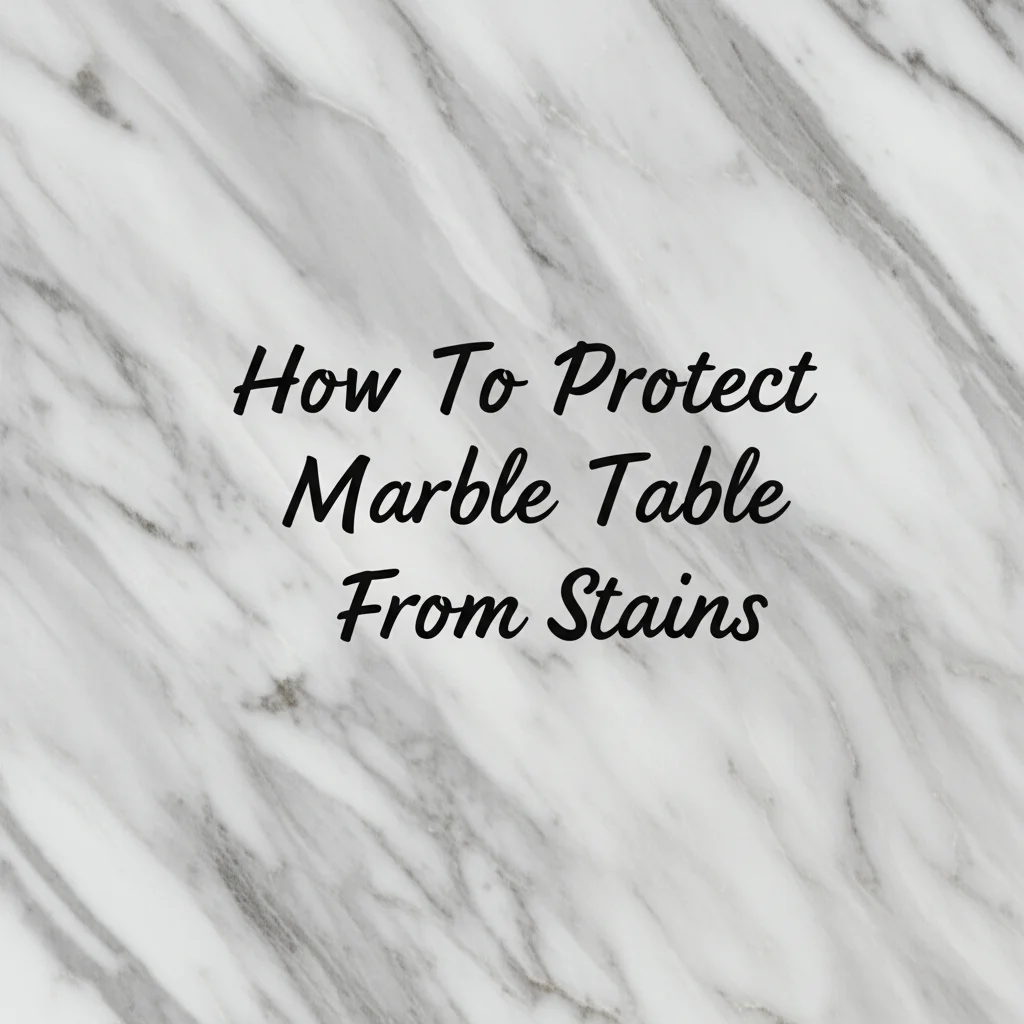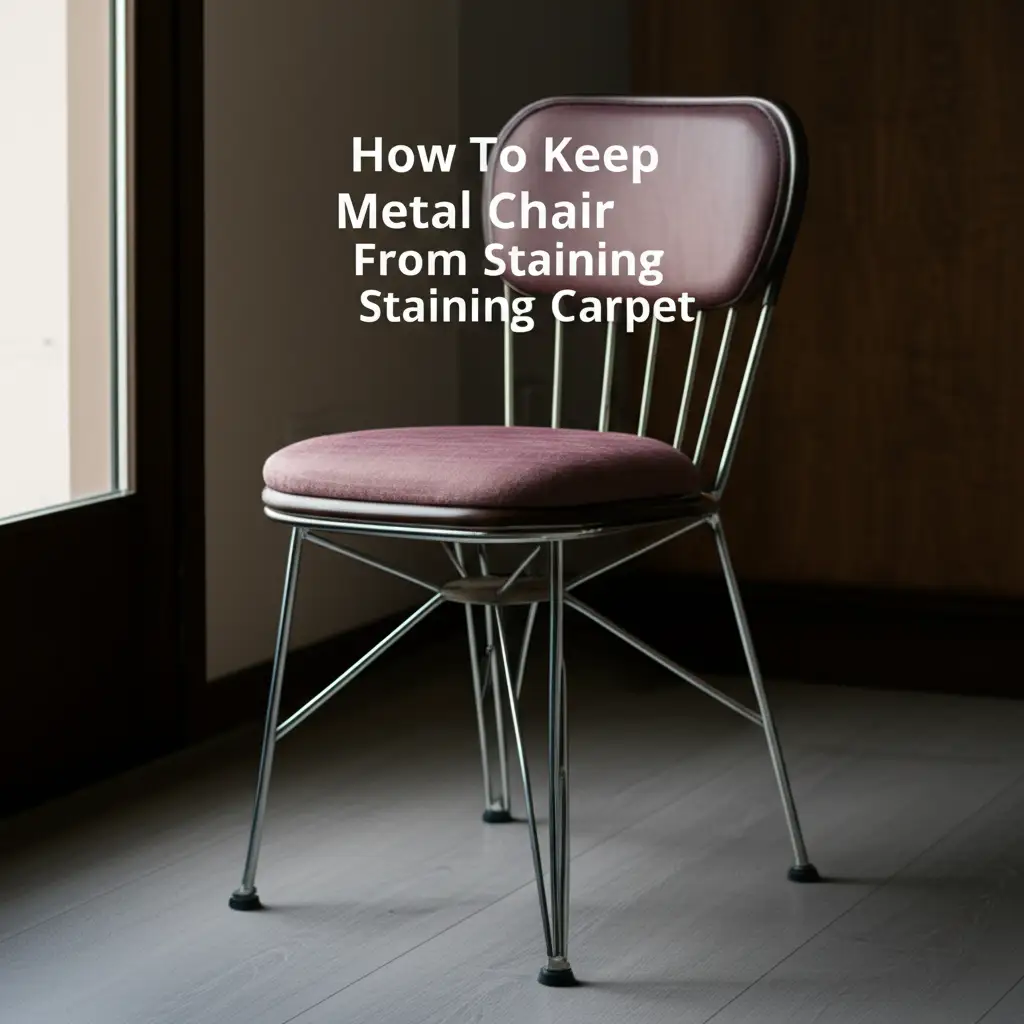· Todd Martin · Home Care · 19 min read
How To Protect Marble Table From Stains

Protect Your Marble Table from Stains: An Essential Guide
Your marble table stands as a symbol of luxury and timeless beauty. This natural stone adds sophistication to any room. However, marble is porous and prone to absorbing liquids, which can lead to unsightly stains. Protecting your marble table from stains is a vital part of owning this beautiful piece.
I understand the desire to keep your marble looking flawless. This comprehensive guide will walk you through effective strategies. We will cover everything from initial sealing to daily care routines and immediate spill management. Follow these steps to ensure your marble table retains its pristine appearance for many years.
Takeaway
- Seal your marble table regularly to create a protective barrier.
- Wipe up spills immediately to prevent absorption and staining.
- Use coasters and placemats for daily protection against rings and etches.
- Clean marble with pH-neutral products and soft cloths.
- Establish a consistent maintenance routine for long-term beauty.
To protect your marble table from stains, routinely apply a high-quality impregnating sealer. Always wipe up spills immediately using a soft, damp cloth. Use coasters, placemats, and tablecloths for daily protection. Clean only with pH-neutral cleaners specifically designed for natural stone.
Understanding Marble’s Vulnerability to Stains
Marble is a metamorphic rock formed from limestone. It primarily consists of calcium carbonate. This composition gives marble its beautiful veining and elegant appearance. However, it also makes marble quite vulnerable to stains and etching.
The primary reason marble stains easily is its porous nature. It has tiny, interconnected pores that can absorb liquids. Anything from spilled coffee to wine or oil can seep into these pores. Once absorbed, these substances leave a discoloration. Different types of stains require specific removal methods, as I have learned.
Etching Versus Staining
It is important to distinguish between etching and staining. Many people confuse the two. A stain occurs when a liquid is absorbed into the marble. This changes the stone’s color. An etch, on the other hand, is chemical damage to the surface. Acidic substances react with the calcium carbonate in marble. This reaction dissolves the polished surface. This leaves a dull, rough spot, even if there is no color change.
Lemon juice, vinegar, and many common household cleaners are acidic. They can cause etching very quickly. While this article focuses on preventing stains, avoiding etches is equally important for marble’s beauty. Both types of damage detract from the marble’s pristine look. Proper protection addresses both concerns.
Understanding these vulnerabilities helps you adopt the right preventive measures. My approach to marble care always starts with respecting its natural properties. Knowing what makes marble susceptible prepares you to provide the best protection. You can read more about how different substances can affect your marble table in our guide on how to clean stains on marble.
The Foundation of Protection: Sealing Your Marble Table
Sealing is the single most important step to protect your marble table from stains. An impregnating sealer penetrates the marble’s pores. It creates an invisible barrier. This barrier repels liquids and prevents them from soaking into the stone. It does not sit on the surface like a wax or polish.
Think of it as adding a raincoat to your marble. The sealer fills the tiny gaps within the stone. This makes it harder for spilled liquids to penetrate. While it does not make marble completely stain-proof, it buys you crucial time. This time allows you to wipe up spills before they cause permanent damage. This step is non-negotiable for anyone serious about marble care.
Choosing the Right Sealer
Selecting the correct sealer is crucial. You need an impregnating sealer designed for natural stone. These sealers are typically silicone-based. They are formulated to repel water, oil, and other common household liquids. Avoid topical sealers or waxes; they do not penetrate the stone and can alter its appearance.
When buying a sealer, check if it is food-safe, especially for dining tables. Reputable brands specializing in stone care usually offer clear instructions. I always recommend testing the sealer in an inconspicuous area first. This ensures it does not change the marble’s color or finish. A good sealer will dry clear and leave no residue.
Application Process
Applying the sealer is a straightforward process. First, ensure your marble table is completely clean and dry. Any dirt or existing stains will be trapped under the sealer. Use a soft, lint-free cloth or a foam brush to apply the sealer generously. Spread it evenly over the entire surface. Let the sealer sit for the time recommended by the manufacturer, usually 15-20 minutes.
During this time, the marble absorbs the sealer. Do not let the sealer dry on the surface. Wipe off any excess sealer with a clean, dry cloth before it dries. Buff the surface gently to remove streaks. Some manufacturers recommend a second coat after a few hours. Always follow the product’s specific instructions for the best results. I find this process simple yet incredibly effective in keeping my marble tables looking great. For deeper insights into general marble cleanliness, refer to our comprehensive guide on how to clean marble table.
How Often to Re-Seal
The frequency of re-sealing depends on several factors. These include the type of marble, how often you use the table, and the specific sealer product. As a general rule, I recommend re-sealing every 1-2 years. High-traffic tables, like dining or kitchen tables, may need it more often. You can perform a simple water test to check if your marble needs re-sealing.
Drop a few tablespoons of water onto the surface. Let it sit for 10-15 minutes. If the water beads up on the surface, the sealer is still effective. If the water starts to soak into the marble and darken the stone, it is time to re-seal. This simple test is a reliable indicator. It helps me maintain optimal protection for my marble table.
Daily Habits for Stain Prevention
Even with a well-sealed marble table, daily habits are critical for preventing stains. These small actions make a big difference. They minimize the risk of spills becoming permanent marks. Consistent daily care protects your investment and preserves its beauty.
I have found that proactive measures are always better than reactive cleaning. It is much easier to prevent a stain than to remove it. Incorporating these simple habits into your routine will keep your marble table looking pristine. They also extend the life of your table’s finish.
Use Coasters, Placemats, and Trivets
This is perhaps the simplest yet most effective daily habit. Always use coasters under glasses, cups, and bottles. Cold drinks can cause condensation rings. These rings can lead to water spots or even etch the surface if left for too long. Hot items can also damage the finish.
Placemats are essential under plates and serving dishes. They provide a protective barrier against food spills. They also prevent scratches from dishware. Trivets are a must for hot pots and pans. Direct heat can cause thermal shock. This can lead to cracks or discoloration. I never place anything directly on my marble table without one of these protections.
Wipe Spills Immediately
Time is of the essence when dealing with spills on marble. Marble is porous, so liquids can quickly penetrate if left to sit. The moment a spill occurs, grab a soft, clean cloth or paper towel. Blot the spill gently. Do not wipe or rub vigorously. Rubbing can spread the liquid further or push it deeper into the pores.
For acidic spills like wine, citrus juice, or soda, immediate action is even more critical. These can etch the surface quickly. Blot the spill, then quickly wipe the area with a damp cloth. Follow up with a dry cloth. This swift response is your best defense against both stains and etches. I have seen firsthand how much difference a few seconds can make. If a spill manages to leave a mark, our guide on how to clean marble table top offers targeted advice.
Avoid Leaving Items on the Surface
Leaving certain items on your marble table for extended periods can also cause problems. This includes decorative objects with rough bottoms. They can scratch the surface. Also, avoid leaving potted plants directly on marble without a protective saucer. Water drainage can seep out and cause a stubborn ring stain.
Always lift objects rather than dragging them across the surface. Regularly rotate decorative items to avoid uneven fading or marks. Periodically, clear your table completely. This allows you to inspect the surface for any unnoticed issues. These small considerations contribute significantly to the long-term protection of your marble table.
Choosing the Right Cleaners and Avoiding Harmful Products
The cleaners you use on your marble table are as important as proper sealing. Using the wrong product can undo all your protective efforts. It can damage the marble’s surface, leading to dullness, etching, or discoloration. My rule is simple: stick to pH-neutral and gentle cleaners.
Many common household cleaners are too harsh for marble. They contain acids, alkalis, or abrasive particles. These ingredients can react negatively with the calcium carbonate in marble. They will strip away sealants and damage the stone itself. Protecting your marble means being very selective about your cleaning supplies.
Use pH-Neutral Cleaners
For daily cleaning, a pH-neutral cleaner is your best friend. These cleaners are specifically formulated for natural stone. They are gentle enough not to harm the marble or strip its sealer. You can find these at most hardware stores or online. Always check the label to ensure it is safe for marble.
I typically dilute a small amount of pH-neutral stone cleaner in warm water. Then, I use a soft cloth to wipe down the table. This mixture effectively removes dust, crumbs, and light grime. After cleaning, always wipe the surface dry with another clean, soft cloth. This prevents water spots or streaks. Using the correct cleaner is vital for maintaining the marble’s integrity. For specific advice on different types of marble, you might find our article on how to clean Carrara marble helpful.
Avoid Acidic and Abrasive Cleaners
Never use acidic cleaners on marble. This includes vinegar, lemon juice, ammonia, bleach, or general bathroom cleaners. These substances will react with the calcium carbonate. This causes etching, which looks like dull spots or rings. Once etched, the only way to restore the shine is usually through professional polishing.
Similarly, avoid abrasive cleaners like scouring powders or steel wool. These can scratch the polished surface of your marble. Even mild abrasive creams can cause micro-scratches over time. These scratches make the surface appear dull and more susceptible to future damage. Always use soft cloths or sponges for cleaning. My cleaning regimen always excludes these harmful products. This cautious approach helps protect my marble table’s smooth finish.
Steer Clear of Wax-Based Polishes
Some furniture polishes contain wax or silicone. These products might seem like a good idea for added shine. However, they are not suitable for marble. Wax-based polishes can build up on the surface. This creates a dull, streaky film over time. They can also trap dirt and make the surface feel sticky.
Furthermore, these polishes do not provide the same protective benefits as an impregnating sealer. They merely sit on the surface. They do not penetrate the stone to repel liquids. Stick to sealers specifically designed for natural stone. For day-to-day shine, a simple wipe with a dry microfiber cloth is usually sufficient.
Dealing with Spills Immediately: The Golden Rule
I cannot stress this enough: immediate action is paramount when a spill occurs on your marble table. This is the “golden rule” of marble protection. No matter how well sealed your table is, marble is still a porous material. Liquids will eventually penetrate if given enough time. Speed is your strongest defense against stains.
Even minor spills like water can leave a mark if left unattended. More aggressive liquids like wine, coffee, or oil pose a significant threat. Acting fast significantly increases your chances of preventing a permanent stain. It also minimizes the risk of etching from acidic substances.
Blot, Don’t Wipe
When a spill happens, resist the urge to wipe it vigorously. Wiping spreads the liquid over a larger area. It also pushes the liquid deeper into the marble’s pores. Instead, use a clean, soft cloth, paper towel, or sponge. Gently blot the liquid. Press down firmly to absorb as much as possible.
Repeat the blotting action with fresh sections of the cloth until no more liquid transfers. For sticky or oily spills, follow up with a damp cloth using a pH-neutral cleaner. Then, dry the area thoroughly with another clean, dry cloth. This blotting technique is much more effective. It lifts the spill rather than pushing it in. Our guide on how to clean marble countertops stains offers detailed steps for various stain types if a stain does occur.
The Urgency of Acidic Spills
Acidic spills like orange juice, wine, coffee, soda, or vinegar require even faster attention. These liquids can not only stain but also etch the marble surface. Etching is a chemical burn that dulls the stone’s polish. It creates a noticeable dull spot.
As soon as an acidic spill occurs, blot it up immediately. Do not delay. After blotting, wipe the area with a damp cloth. Then, dry it quickly. While sealers provide some protection, they cannot entirely prevent etching if acidic liquids sit for too long. Swift action is the only way to avoid this permanent damage. My experience has shown me that every second counts with acidic spills.
Emergency Spill Kit
Consider keeping a small emergency spill kit nearby your marble table. This kit can contain:
- Several soft, absorbent cloths (microfiber works well).
- A roll of paper towels.
- A small spray bottle with diluted pH-neutral marble cleaner.
- A dry polishing cloth.
Having these items readily accessible saves precious time during an unexpected spill. You won’t waste moments searching for supplies. This preparedness ensures you can respond quickly and effectively. It significantly boosts your marble table’s protection against stains and etches. This simple setup has saved my marble table from countless potential disasters.
Protective Coverings and Accessories
Beyond sealing and immediate spill response, physical barriers offer an extra layer of protection. These coverings shield your marble table from daily wear and tear. They guard against scratches, heat damage, and minor spills that might go unnoticed. Integrating these accessories into your daily use routine is a smart move for long-term marble care.
I always recommend using a combination of these items. They provide comprehensive protection. This approach helps maintain the beauty of your marble table for years to come. These simple additions can save you from costly repairs or the heartache of a permanently damaged surface.
Tablecloths for Major Protection
A tablecloth offers the most extensive protection for your marble table. It covers the entire surface. This guards against spills, scratches, and heat. For everyday use, a washable tablecloth is practical. For special occasions or meals, a more decorative tablecloth can elevate your dining experience while protecting the table.
When choosing a tablecloth, consider its material. Thick, absorbent fabrics provide better protection against spills. Ensure the tablecloth is large enough to drape over the edges. This protects the sides of the table as well. I often use a tablecloth when I have guests or when children are around. It provides peace of mind.
Custom Table Pads
Custom table pads offer superior protection, especially for dining tables. These pads are typically made from a rigid core. They are covered with felt or vinyl. They are designed to fit your table’s exact dimensions. Table pads provide excellent defense against impacts, heat, and spills.
Many table pads come in foldable sections for easy storage. They create a flat, stable surface for dining. While they might conceal the marble, they are indispensable for serious protection during meals or activities. I use custom pads when I am concerned about heavy use or potential accidents. They truly offer robust defense.
Decorative Runners and Placemats
For a more aesthetic approach, combine decorative runners and placemats. A runner protects the central part of your table. It is ideal for showcasing decorative items. Placemats protect individual place settings from plates, cutlery, and incidental spills.
Choose materials that are soft and non-abrasive. Avoid anything with rough backing that could scratch the marble. These accessories not only protect but also enhance your table’s appearance. They add color and texture to your decor. I find them perfect for everyday use when I want to appreciate the marble’s beauty while still providing protection.
Using Trays for Serving
When serving food or drinks, especially those with high spill potential, use trays. A sturdy tray provides a contained area for items. This reduces the risk of direct spills onto the marble. If a drink spills on the tray, it is much easier to clean up.
Trays are particularly useful for carrying multiple items. They also work well for serving messy foods like sauces or fruit bowls. After serving, you can easily remove the tray for cleaning. This simple habit adds an effective layer of defense against accidental spills. It keeps liquids contained.
Regular Maintenance and Inspection
Consistent maintenance is key to protecting your marble table from stains long-term. This goes beyond just cleaning up spills. It involves routine checks and gentle care to ensure the protective measures remain effective. A well-maintained marble table is less likely to suffer from stains or damage.
I believe regular inspection helps catch potential issues early. Addressing minor problems before they escalate prevents more significant damage. This proactive approach saves time, effort, and money in the long run. My marble tables remain beautiful because of this diligent routine.
Daily Cleaning Routine
Establish a simple daily cleaning routine. After each use, wipe down your marble table with a soft, damp cloth. Use plain water or a very diluted pH-neutral stone cleaner. This removes dust, crumbs, and light surface grime. Always follow up with a dry microfiber cloth to prevent water spots and streaks.
This quick wipe-down prevents everyday debris from accumulating. It also helps you spot any new spills or marks promptly. Consistency is crucial here. A daily wipe keeps your marble looking its best with minimal effort. This habit makes a significant difference over time. For more general advice on keeping your marble clean, our article on how to clean marble provides a good foundation.
Periodic Deep Cleaning
Every few weeks or months, depending on use, perform a slightly deeper clean. Use your pH-neutral stone cleaner according to its instructions. Apply it evenly with a soft cloth. Let it sit for a moment to loosen any grime. Then, wipe it clean and dry the surface thoroughly.
This periodic deep clean removes any residue that might build up over time. It ensures the surface remains clean and ready for re-sealing when needed. Avoid harsh scrubbing or abrasive tools during this process. Gentle care is always the best approach for marble. This ritual keeps my marble tables sparkling without damaging the finish.
Regular Sealer Checks
As mentioned earlier, regularly test your marble’s sealer effectiveness. Perform the water bead test every few months. Drop water on the surface and observe if it beads up or soaks in. If the water begins to absorb, it is time to re-seal your table.
Re-sealing is a vital part of long-term protection. It replenishes the protective barrier that repels liquids. Ignoring this step can leave your marble vulnerable to staining. Mark your calendar for re-sealing intervals. This ensures you never miss this crucial protective measure. This proactive step is crucial for ongoing stain resistance.
Inspect for Scratches and Etches
During your cleaning routine, take time to inspect the marble surface closely. Look for any new scratches, dull spots (etches), or minor stains. Catching these issues early allows for quicker remediation. Small scratches can sometimes be buffed out. Minor etches might be reduced with specialized etch removers.
Addressing these imperfections promptly prevents them from worsening. It also maintains the overall pristine appearance of your table. If you notice persistent dullness or significant etching, consider professional help. A stone restoration specialist can often re-polish or refinish the surface. Regular inspections help maintain both the protection and beauty of your marble. For severe damage, our guide on how to restore a marble table top offers solutions.
FAQ Section
How often should I seal my marble table?
You should typically seal your marble table every 1-2 years. However, this frequency can vary based on usage and the type of sealer. High-traffic tables may need more frequent sealing. Perform a simple water test regularly: if water soaks in instead of beading up, it’s time to re-seal.
What type of sealer is best for marble tables?
An impregnating sealer designed for natural stone is best. These sealers penetrate the marble’s pores, creating a barrier that repels liquids. Look for silicone-based, food-safe options if it’s a dining table. Avoid topical sealers or waxes, as they don’t offer true protection.
Can I use natural cleaners like vinegar on marble?
No, you should never use acidic cleaners like vinegar, lemon juice, or bleach on marble. Marble is calcium carbonate, which reacts with acids. This reaction causes etching, leading to dull, rough spots on the surface. Always use pH-neutral cleaners specifically formulated for natural stone.
Are marble tables difficult to maintain?
Marble tables require specific care but are not overly difficult to maintain. The key is consistent preventive measures. Regular sealing, immediate spill cleanup, and using coasters/placemats are crucial. Avoid harsh chemicals. With these habits, maintaining a marble table is manageable.
What’s the difference between etching and staining?
A stain is a discoloration caused by a liquid being absorbed into the marble’s pores. Etching is chemical damage to the marble’s surface, typically from acidic substances. It appears as a dull, rough spot where the polish has been dissolved, regardless of color change.
Do placemats and coasters really help?
Yes, placemats and coasters are extremely helpful. They create a physical barrier between your table and potentially damaging items. Coasters prevent water rings and etching from cold or hot drinks. Placemats protect against food spills and scratches from dishes. They are essential for daily protection.
Conclusion
Protecting your elegant marble table from stains is a commitment, but it is a worthwhile one. By understanding marble’s inherent vulnerabilities, you can implement effective preventive strategies. Sealing your marble table properly is the cornerstone of this protection. It creates an invisible shield against potential stains.
Beyond sealing, adopting mindful daily habits is crucial. Always use coasters and placemats. Wipe up any spills immediately, especially acidic ones, using a blotting motion. Choose only pH-neutral cleaners to avoid damaging the stone’s delicate surface. By consistently following these guidelines, you will preserve your marble table’s pristine beauty for many years to come. Your beautiful marble deserves this dedicated care. Take these steps today and enjoy your stunning, stain-resistant marble table.





